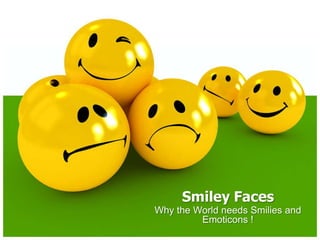
Smiley presentation
- 1. Smiley Faces Why the World needs Smilies and Emoticons !
- 2. Smiley A smiley, or happy face, (☺/☻) is a stylized representation of a smiling human face, commonly represented as a yellow (many other colors are also used) circle (or sphere) with two black dots representing eyes and a black half circle representing the mouth. “Smiley” is also sometimes used as a generic term for any emoticon. The variant spelling "smilie" is not as common, but the plural form "smilies" (the plural of "smily", not "smiley") is commonly used.
- 3. Popularization The first Unhappy face recorded on film can be seen in Ingmar Bergman's 1948 film "Hamnstad" . Later on, in 1953 and 1958, the happy face was used in promotional campaigns for motion pictures 'Lili' and 'Gigi', respectively. The Happy face was first introduced to popular culture in 1958 when the WMCA radio station in New York ran a competition for the most popular radio show at the time, 'Cousin Brucie'. Listeners who answered their phone 'WMCA Good Guys!', were rewarded with a 'Good Guys!' sweatshirt that incorporated a Happy face into its design. Thousands of these sweatshirts were given away during the late 1950s, and soon after, Harvey Ball, an American commercial artist, was employed by an advertising company to create a happy face to be used on buttons.
- 4. Popularization The graphic was popularized in the early 1970s by Philadelphia brothers Bernard and Murray Spain, who seized upon it in September 1970 in a campaign to sell novelty items. The two produced buttons as well as coffee mugs, t-shirts, bumper stickers and many other items emblazoned with the symbol and the phrase "Have a happy day" (devised by GyulaBogar) which mutated into "have a nice day". Working with New York button manufacturer NG Slater, some 50 million happy face badges were produced by 1972. In the UK, the happy face is associated with psychedelic culture since Ubi Dwyer and the Windsor Free Festival in the 1970s and the dance music culture that emerged during the second summer of love in the late 1980s. The association was cemented when the band Bomb The Bass used an extracted smiley from Watchmen on the centre of its Beat Dis hit single.
- 5. Popularization In the 1970s, the happy face (and the accompanying 'have a nice day' mantra) is also said to have become a zombifying hollow sentiment, emblematic of Richard Nixon-era America and the passing from the optimism of the Summer of Love into the more cynical decade that followed. This motif is evidenced in the era of paranoid soul such as "Smiling Faces Sometimes" (released by The Temptations in April 1971, and by The Undisputed Truth in July 1971), "I'll Take You There" (The Staples Singers, 1972), "Don't Call Me Brother" (The O'Jays, 1973), "Back Stabbers" (The O'Jays), and "You Caught Me Smilin'" (Sly and the Family Stone, 1971). The origins of this was parodied in a famous scene from the movie Forrest Gump when Forrest is on his multiple jogs across America, and wipes his face on a T shirt given him by a struggling salesman, and on the shirt, as if transferred there by Forrest's face, reminiscent of the Shroud of Turin, is the image of the happy face, whereupon the man gets his idea. The happy face was also seen on a van in a scene from Mork and Mindy, the van driven by men who kidnap them.
- 7. Usage in Informatics The smiley is the printable version of characters 1 and 2 of (black and white versions) of codepage 437 (1981) of the first IBM PC and all subsequentes PC compatible computers. For modern computers, all versions of Microsoft Windows after Windows 95can use the smiley as part of Windows Glyph List 4, although some computer fonts missed some characters, and some characters couldn't be reproduced by programs not compatible with Unicode. It also appears in Unicode's Basic Multilingual Plane.
- 8. Usage in Informatics Unicode smiley characters : ☺ 0x263a White Smiling Face ☻ 0x263b Black Smiling Face Unicode also contains the "sad" face: ☹ 0x2639 White Frowning Face
- 9. Licensing and legal issues Smiley has been a registered trademark in some countries since 1971 when French journalist Franklin Loufrani created "The Smiley Licensing corporation limited" to sell, advertise and license the smiley face image in the United Kingdom and Europe. Loufrani had created the icon in 1971 to highlight good news in newspaper articles.In 2001 the name of the company has changed to become SmileyWorld. The Smiley name and logo is registered and used in over 100 countries for 25 classes of goods and services. In 1999, Harvey Ball formed World Smile Corporation and began licensing the happy face to fund charitable causes. Profits are distributed to charities through the Harvey Ball World Smile Foundation, which also sponsors the annual World Smile Day Ball started in 1999 to encourage "acts of kindness."
- 10. Licensing and legal issues In 2006 Wal-Mart, which prominently featured a happy face in its "Rolling Back Prices" campaign, sought to trademark the happy face in the United States, coming into legal conflict with Loufrani and Smiley World over the matter.In 2006 Wal-mart began to phase out the smiley face on its vests and its website.During a trademark infringement case against an online parodist, Wal-Mart again tried to claim it held the trademark rights to the yellow happy face. In March 2008, Wal-Mart lost the case and the judge stated in his decision that Wal-Mart did not own rights to the happy face.
